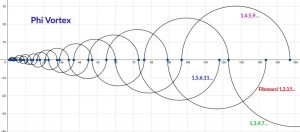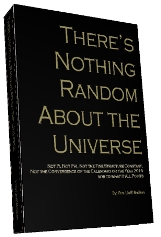Have an amazing Purim everyone! And let us all connect to H’Mashiach and Hashem through the concealed. It is up to us the reveal them in our lives and world, the world of Malchut. This is what the Megillah Ester and the so-called traditions (actually the technology)of Purim allows us to do. There was a wonderful extended comment at the DailyZohar.com by Chaim that I would like to shared with everyone.
One of the many things Chaim shows us is how all the sefirot (dimensions) are included in the text of the Book of Ester except the sefira of Netzach and he deftly explains why. The only thing I would add to Chaim’s article is that the word Netzach, representing the 4th sefira, that of victory associated with Moshe Rabbeinu, is found once in the amazingly encoded Book of Ester. At Ester 6:4 it is found backwards and combined every other letter with the Name of G-d (YHVH): HChYZVNH. This, like all the technology built into the Megillah Ester, is no coincidence and strengthens Chaim’s learned hypothesis as G-d chose to conceal himself within Netzach. There are numerous other times throughout the reading that the names of G-d are similarly encoded within words or phrases, and it is through their ultimate revelation that the Light shines into our lives.
Chag Sameach,
Purim Sameach,
Ezra
Please read Chaim’s article in its entirety
Chaim says:
February 26, 2010 at 5:01 am
The Megilah and Kabbalistic Terminology
It is not surprising that hidden within the text of the book of Esther, one may find numerous allusions to concepts and terms which in subsequent generations were to become mainstays of Kabbalistic discourse. Aside from the importance accorded the Hebrew root of the word Kabbalah (k-b-l) itself (Esther 4:4: “And [Esther] sent garments with which to clothe Mordechai…but he did not accept (kibel) [them]“; Esther 9:23: “And the Jews accepted (kiblu) that which they had begun to do…”; Esther 9:27: “The Jews established and accepted upon themselves, and upon their seed”), we find many other significant word-roots appearing there as well.
Of the eleven names for the sefirot–the basic Divine forces of Creation–all but one explicitly appear in the book of Esther.
Keter appears in 1:11, 2:17, and 6:1;
Chochmah in 1:13 and 6:13;
Binah in 3:8; da’at in 1:13;
Chesed in 2:17;
Gevurah in 10:2;
Tiferet in 1:4;
Hod in 2:5, 3:4, et al;
Yesod in 1:8,
And malchut in 1:7,11,19 et al.
The only sefirotic term missing in the book is netzach, as we will explain further on.
No other Biblical text exhibits such a density of Kabbalistic idiom. The fact that this abundance of mystical expression coexists alongside a total absence of reference to G-d Himself can perhaps be understood by way of analogy to a panorama of stars that only becomes visible when the radiance of the sun has receded from view.
The term sefirah itself, perhaps the most basic within the lexicon of Kabbalah, finds repeated expression in this book through the related term sefer , “book” (Esther 2:23, 6:1, 10:2, 9:25, 32, et al), constructed from the same Hebrew root, s-f-r.
This root bears three distinct connotations, all of which are reflected in the meaning of the word sefirah. As an “emanation” of Divine light, the term sefirah is derived from the Biblical sapir, “sapphire,” whose brilliant radiance is associated with the heavenly throne and footstool envisioned by the prophets.
The term sefirah also alludes to a specific attribute or trait by which G-d expresses Himself in the world. As such, it reflects an additional connotation of the root s-f-r, that of “articulation,” as in the words sippur (“story”) and sefer (“book”). Unlike the transcendent association with Divine light, this aspect of the root s-f-r implies a more immediate and relatable context through which to identify with G-d.
Finally, the term sefirah often alludes to the abstract mathematical structure of Creation–as evoked by the word mispar (“number”). In this sense, the concept of sefirah is only obliquely connected to Divinity–reflecting a dimension which, albeit exquisitely abstract, attaches to the created realm itself.
The association between the term sefirah and the word sefer, which as we just saw is based upon the idea of articulation or expressiveness, is underscored by the fact that the book of Esther itself is called a megilah (“scroll”), based upon the root gilah, “to reveal.”
The physical form of the scroll itself reinforces this sense of revelation by contributing to the reader’s experience of the text as a gradually unfolding message or insight. This effect is heightened even further by the use of the sippur (“narrative medium”) as the literary format for communicating the message of the scroll. In the sippur there is a constant tension deriving from the selective revelation of certain plot-elements and not others. The gradual clarification of all the hidden aspects within a story brings with it a cathartic resolution of that tension and a much deeper connection to the literary themes evoked in the process. No other account in all of Scripture takes such full advantage of the narrative medium as the story of Esther.
The Kabbalistic tradition also resorts to allegorical narrative when attempting to communicate its profound truths–as such form of exposition often proves more illuminating than abstract theosophical discourse. The story of Creation and of man’s first hours in Eden provides Kabbalah with a key narrative structure for presenting the cosmic background to man’s existence. Given the connection that we have seen between the book of Esther and Kabbalistic tradition, it should not surprise us, then, that the story of Esther is in fact interpreted in Kabbalah as symbolic of the initial drama that transpired in Eden at the dawn of Creation, when the first man and woman were tempted into eating from the Tree of Knowledge. The key figures in the book of Esther are seen as representing the regenerated souls (gilgulim) of the players in that great drama, come to rectify their prior “fall.” Esther, by vanquishing the serpent Haman, provides necessary restitution for the tragic flaw in Creation engendered by her primordial ancestor, Eve.
The most frequently mentioned sefirotic term in the book of Esther is malchut. No other Biblical text contains such a concentration of references to the term malchut. Out of a total of 167 verses in the book, there are over 240 appearances of the root melech. In one verse (Esther 4:11), the word hamelech actually appears five times. In another verse (Esther 5:1), the root melech appears in variant forms a full six times! This itself is a major indication of the Book of Esther’s strong Kabbalistic character, as malchut is the key to understanding the entire drama of Creation according to the Kabbalah.
The root melech appears most often in context of the word hamelech (“the king”), referring to the Persian King Achashverosh. It is commonly explained that the various references in the book of Esther to King Achashverosh can otherwise be interpreted as veiled allusions to the King of Kings, Master of the universe. The fact that he is always referred to as hamelech (the king) would seems to corroborate this tradition. The letter hei, serving as definite article in the word hamelech, is the letter associated in Kabbalah with the sefirah of malchut–corresponding to the final hei in G-d’s essential four-letter Name.
Another indication of the Kabbalistic spirit infusing the text is the fact that the word keter (alluding to the first Divine emanation) always appears in conjunction with the word malchut (alluding to the last). The expression keter malchut (“the royal crown”) hints at a basic Kabbalistic phenomenon, described by Sefer Yetzirah in the following language: “its end (the sefirah of malchut) is enwedged in its beginning (that of keter) as its beginning is enwedged in its end.” (The introduction of the Tikunei Zohar [s.v. Patach Eliahu] also states: “the supernal keter is the keter of malchut.”)
Interestingly enough, the second most frequently mentioned sefirah in the book of Esther is hod. The relationship between hod and malchut is a very significant one, insofar as we are told in Kabbalah that ihi b’hod–”she (the sefirah of malchut) is in hod.” In the very first verse of the book, we already find an allusion to the strong association between these two terms–as it states there hu Achashverosh hamolech mehodu v’ad kush. Elsewhere (in Daniel 11:21 and I Chronicles 29:25), the two terms combine into the idiom hod malchut (“the aura of majesty”), an expression used often in addressing royalty.
The only sefirotic term missing in the book is netzach, the seventh sefirah and one which has unique relevance to the holiday of Purim at which time the events of the book of Esther are commemorated. (The Arizal states that it is on Purim that the sefirah of netzach achieves its tikkun, i.e. rectified expression.) It would thus appear that the absence of the term netzach from the text, like the absence of G-d’s Name, actually points in a paradoxical way to the term’s pervasive, and thus unrecognizable, presence throughout the book as a whole. A further indication of there being an equivalence between the term netzach and G-d’s Name is the fact that of all the names identified with the sefirot, netzach is the only one which appears in Scripture (I Samuel 15:29) as poetically descriptive of G-d Himself: Netzach Yisrael (“the Eternity of Israel”).
The essential relevance of netzach to the book of Esther derives from its dual connotation of both “victory” and “eternity.” As “victory,” netzach represents the capacity to overcome adversity. As “eternity,” it implies the capacity to even overcome the adversity of death itself. The “eternity of Israel,” and of its struggle against the nation of Amalek (their Biblical arch-enemy, representing the forces of doubt and indifference, especially with regard to faith in Divine providence), are the central themes of the book of Esther and of the Purim holiday associated with it. Our sages teach us that in Messianic times all the holidays we presently observe will be annulled except for Purim–meaning that the intensity of Divine revelation at that time will virtually blind out the significance of the other holidays, but not that of Purim. The same is said with regard to the status of the book of Esther vis-a-vis the other books of the Prophets and Ketuvim. This is actually alluded to in the book of Esther itself (9:28): “And these days of Purim shall never pass from among the Jews nor shall their commemoration ever cease from among their seed.”
The Hebrew expression lo yasuf (“shall never cease”) in the above verse recalls the term ein sof (“endlessness,” or “the Infinite One”), the idiom in Kabbalah expressing G-d’s essential existence beyond time and space. (The initial letters of ein sof, the alef and samech,are also the first two letters in Esther’s name.) It is interesting to note that we find an idiomatic expression of eternity in each of the three places where the Bible explicitly recounts the campaign against Amalek: In the Pentateuch itself, where Moses and Joshua lead the battle, we are told of “G-d’s war against Amalek from generation to generation” (Exodus 17:16); in the Prophets, where Samuel contends with the Amalekite King, Agag, we encounter the Divine appelation referred to above–Netzach Yisrael, the Eternity of Israel; and in the Ketuvim, where Mordechai and Esther vanquish the Amalekite Haman, we have the expression just mentioned, lo yasuf.
Hence we see that the concept of netzach is implicit throughout the book of Esther. It can be said that it “surrounds” the book as well–for we find explicit reference to the term both before and after the book is formally read on the holiday of Purim. The prior reference appears in context of the haftarah (“appended Scriptural portion”) read on the Sabbath before the Purim holiday, in which the central verse (Samuel 15:29) reads: “Netzach Yisrael lo yeshaker”–”the Eternity of Israel does not prevaricate.” The subsequent reference appears in the short elegy, “Shoshanat Yaakov,” which is recited after the book of Esther has been read in public. The word netzach appears there twice, in the sentence that reads teshuatam hayita lanetzach (“you were their eternal salvation”) and in that which reads lo yekalmu lanetzach kol hachosim bach (“those who find refuge in You shall for all of eternity never be humiliated”).
Hence, in one form or another, all of the sefirot are hinted at in the Megillah, establishing a unique connection between this most esoteric of Scriptural texts and the Kabbalistic tradition as a whole.




